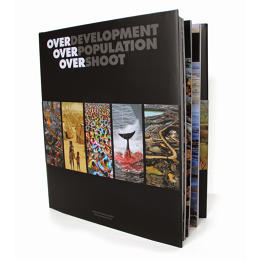These Photos Tackle An Uncomfortable Question: What If There Are Just Too Many People On Earth?
Population control is taboo. But it wasn’t always that way—and a new book, showing images ranging from a mall on Black Friday to a shepherd in Mongolia, could open up the conversation.
In the world of solutions to environmental problems, one topic rarely gets any discussion: Birth control. By 2050, the U.N. estimates that the human population will hit 9.6 billion, putting unprecedented pressure on the planet’s energy and agriculture systems. But that estimate tends to be accepted as inevitable, rather than as a number that could (or should) change.
A new book called Over tries to tell the story of population in a different way. It shares photos of a world that’s arguably already overcrowded, rather than focusing on statistics alone. Then, it talks about what we might do differently.

Read a story about climate change, or the fact that half of the world’s species have disappeared since 1970, and there probably won’t be much, if any, discussion of the role of a growing population in shaping those issues. And stories focused on the dry statistics of population estimates don’t get much play.
By showing the state of the world today—from slum housing in Haiti to factory farm feedlots to a mall on Black Friday—the book aims to connect emotionally with readers before trying to make a case for change.
“The point of a large-format book was to jump over those rational arguments that no one’s paying any attention to, and try to do something incredibly simple,” says Tom Butler, editorial director at the Foundation for Deep Ecology and editor of the book. “And that is to show essentially a slide show of a global tour of the world as transformed by numbers and behavior.”

The subject of population control wasn’t always taboo. “The bestselling environment-related book of the ’60s and ’70s was not Silent Spring, it was Paul Ehrlich’s Population Bomb,” says Butler. “So this was a huge and integrated topic of conversation decades ago, and then it fell off the radar screen.”
Part of the challenge is that the topic is now politically fraught both for the right and left. “On the right, if we’re talking about the demographic trajectory of the human family, inevitably, this brings up questions of sexuality, abortion, immigration, women’s rights, gender equity—all kinds of hot button issues,” he says. “And then on the far ends of the left spectrum, there’s a radical fringe that has tried to portray family planning as equal to coercion.”
There’s also the challenge that the numbers for projected population growth are so large that they tend to become abstract and meaningless. “I think part of the reason we don’t talk about population problem is that demographic data is boring and people can’t imagine what those numbers really mean, unless you put it in a way that’s understandable to a normal person,” Butler says.
But, he argues, addressing population could be one of the most straightforward ways to tackle other issues like climate change—unlike transforming the energy economy, for example, the solutions are relatively simple and cheap.
“In terms of slowing population momentum, we know what works,” he says. “If you elevate the status of women, educate girls, and make family planning tools and information universally available, birth rates come down rapidly. This happens across cultures. It can be done in a way that is culturally appropriate, that empowers women and their partners to make free choices. It’s a victory for human beings that can reduce suffering.”
It’s a change that would require political will more than a massive budget—maybe a mere $3.5 billion he estimates to provide family planning for all women on Earth who don’t currently have access. “That’s less than 4% of what Americans pay for beer every year. It is a trivial sum to solve that unmet need gap in family planning,” he says.

Some argue that technological solutions can rise to meet the needs of another few billion people on the planet—just as advances in agriculture helped defeat Malthusian predictions of running out of food. But Butler believes that technology alone isn’t sufficient to address problems like climate change and plummeting biodiversity.
“I absolutely do not believe that the innovations in technology will solve all of these problems, as if by magic, if you don’t solve the underlying issues,” he says. “You can’t treat the symptoms and not the underlying root causes and hope that the patient will get better. The patient may not die as quickly, you can buy time, but the fundamental reality is that you cannot grow perpetually on a finite planet.”
New studies suggest that population isn’t likely to level off anytime soon, as earlier estimates had suggested. By 2100, on our current trajectory, some scientists believe that world may be home to as many as 13 billion people.
Fast Company , Read Full Story
(150)














